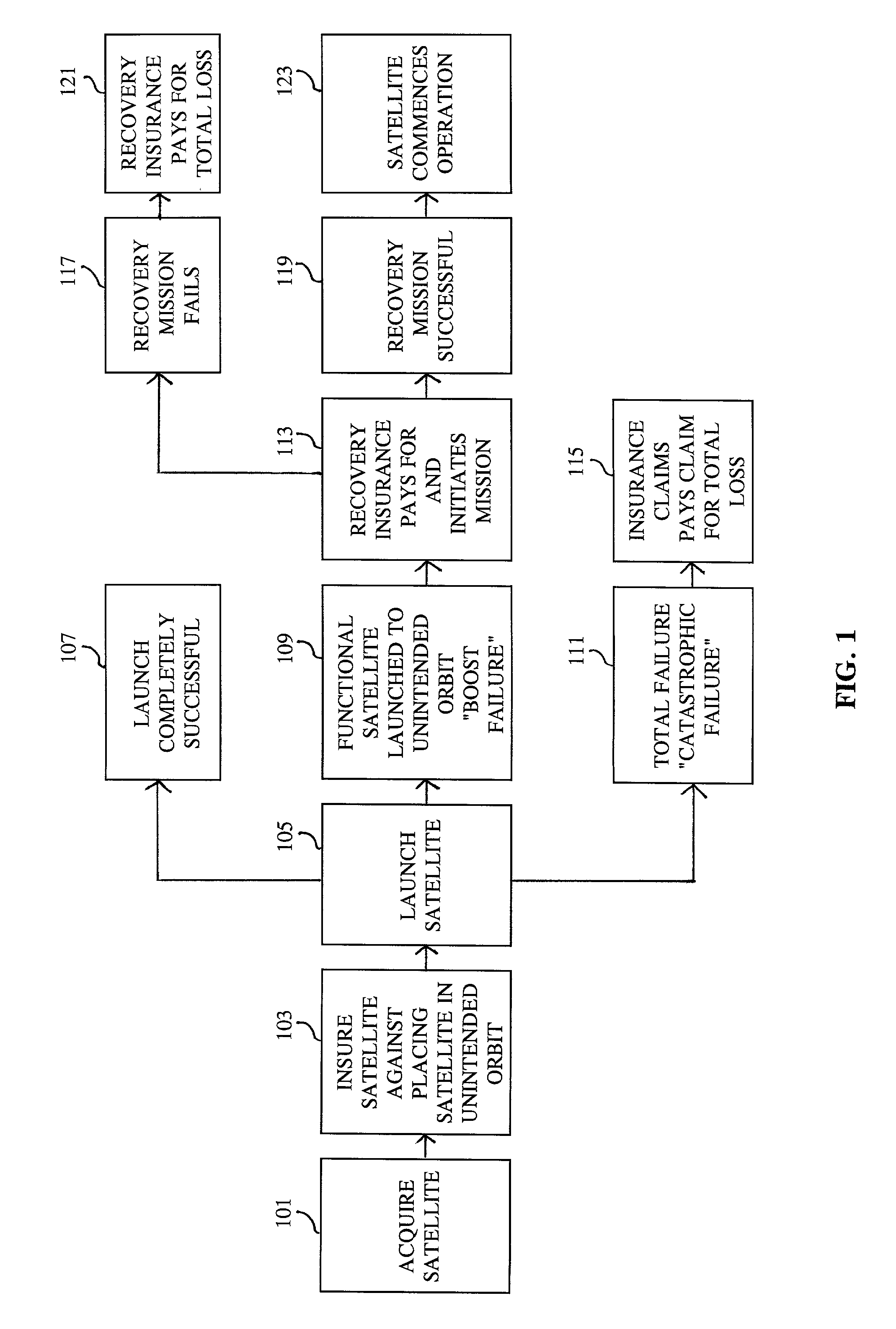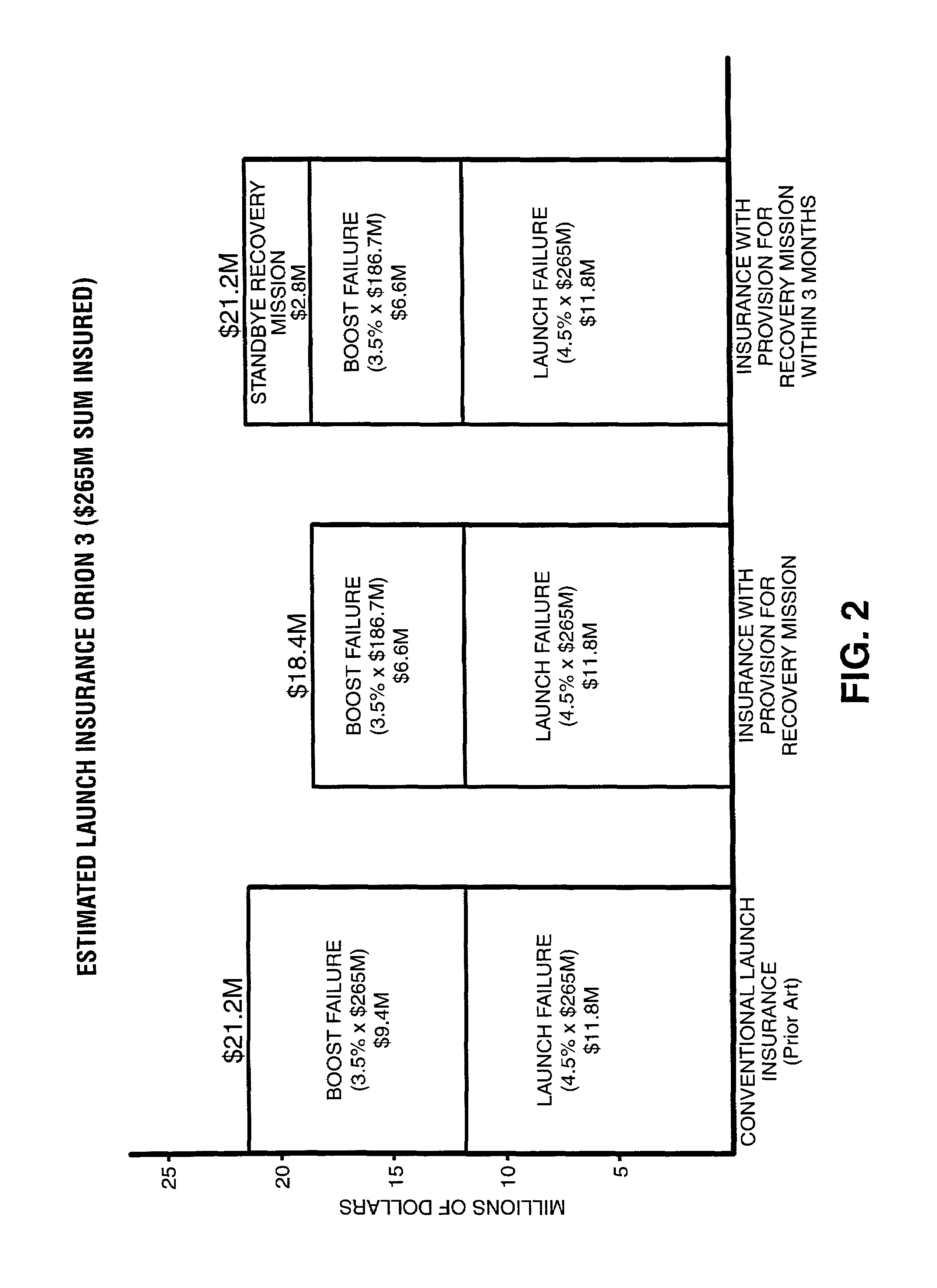Method of insuring against satellite launch failure
- Summary
- Abstract
- Description
- Claims
- Application Information
AI Technical Summary
Benefits of technology
Problems solved by technology
Method used
Image
Examples
example 1
[0038]In a preferred practice of the present invention, launch insurance including a policy for providing a recovery mission is provided to the satellite owner at a cost less than the premium for obtaining conventional insurance.
[0039]On May 5, 1999, the Orion 3 communications satellite was launched into an unplanned orbit by the failure of the Centaur upper stage on the Boeing Delta III launch vehicle. According to public reports, the satellite was launched into an orbit of 85×744 nautical miles, far short of its specified launch insertion orbit of 100×13,886 nautical miles. On May 7, 1999, Orion 3 was transferred to an orbit of 228×711 nautical miles to prolong its life. The satellite appears to be fully functional but does not have sufficient onboard propellant to transfer it to its planned geostationary orbit of 22,300 nautical miles. The satellite and launch were insured for $265 million. It has been estimated that it would cost approximately $186.7 million to initiate a recove...
example 2
[0044]The following example is presented to illustrate a preferred practice of the invention including variables involved for a higher value satellite launched on a lower risk launch vehicle. This “satellite X” is ensured for $430 million and is launched on the Ariane 4 launch vehicle.
Insurance Summary
[0045]
Launch Vehicle: Ariane 4RateAmount(%)($M)1. Original Launch - ConventionalSum Insured430.0Launch Phase Premium Rate (est) 4.5Launch Phase Premiums (estimate)Launch Vehicle Failure2.510.8Boost Failure2.08.6Total Premium19.42. Recovery CostRecovery Mission (w / Profit %)154.0Insurance for RMSum Insured430.0Premium Rate / Cost22.094.6Total Recovery Cost248.63. Original Launch with ReservationSum InsuredLaunch Vehicle Failure430.0Boost Failure248.6Launch Phase Premium Rate4.5Launch Phase PremiumsLaunch Vehicle Failure2.510.8Boost Failure2.04.9Total Premium w / Res15.74. Reservation Premium Residual (Savings)Conventional Premium19.4Premium with Reservation15.7Standby Mission Prem...
example 3
[0048]In a non-preferred embodiment of the invention, the insurance policy for a recovery mission is offered to a satellite owner at a price in addition to the cost of a conventional launch insurance policy. As is explained in greater detail above, the premium for launch insurance including the recovery mission provision would more likely be less costly than conventional launch insurance. However, for purposes of simplicity and explanation, this example will describe an insurance policy of the present invention in which the recovery mission policy is paid for in addition to conventional launch insurance.
[0049]In March 1994 the U.S. Navy launched a military communications satellite UHF-1 on an Atlas I which suffered a boost failure. The estimated value for the satellite was $142 million with an additional $45.7 million for launch, for a total of $187.7 million. A 12% insurance rate was charged to the U.S. Navy resulting in a $22.5 million insurance premium.
[0050]Recovery mission insu...
PUM
 Login to View More
Login to View More Abstract
Description
Claims
Application Information
 Login to View More
Login to View More - R&D
- Intellectual Property
- Life Sciences
- Materials
- Tech Scout
- Unparalleled Data Quality
- Higher Quality Content
- 60% Fewer Hallucinations
Browse by: Latest US Patents, China's latest patents, Technical Efficacy Thesaurus, Application Domain, Technology Topic, Popular Technical Reports.
© 2025 PatSnap. All rights reserved.Legal|Privacy policy|Modern Slavery Act Transparency Statement|Sitemap|About US| Contact US: help@patsnap.com



